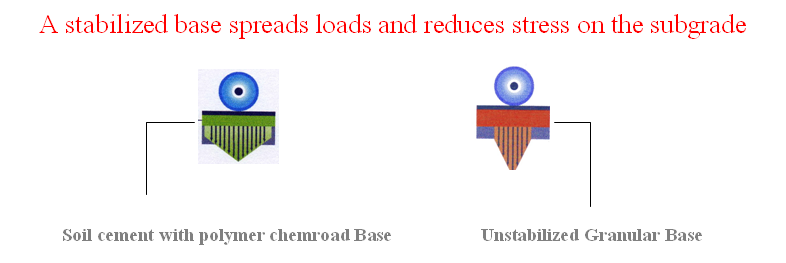Distributes Loads. Soil cement with polymer chemroad base will be much stronger and more rigid than an unstabilized granular base. This higher stiffness of the cement-treated base will act to distribute loads over a wider area, reducing the stresses on the subgrade and acting as the load carrying element of a flexible pavement.
Eliminates Rutting in Base. Rutting will not occur in a Soil cement with polymer chemroad base.If rutting occurs in a granular base, or the sub-grade, a simple overlay of the pavement surface cannot fix the problem that led to the rutting in the first place. With a Soil cement with polymer chemroad base, rutting is confined to the asphalt surface layer and is relatively simple to correct. A Soil cement with polymer chemroad base will keep rutting from occurring deep in the pavement where it is extremely difficult to repair.
Reduces Moisture Problems. Soil cement with polymer chemroad bases are designed to be virtually impermeable.This keeps water out of the base, so that even under frost conditions no ice lenses can form in the base layer. With a granular material, if poor drain-age exists or groundwater rises, the base can easily become saturated. When this happens with an unbound material,signify-cant strength losses occur. The Soil cement with polymer chemroad layer, being a bound material, will main significant strength even in the unlikely event it becomes saturated.
Reduces Deflection. The higher stiffness of Soil cement with polymer chemroad bases will lead to lower pavement deflections and lower asphalt strains.This will result in longer fatigue life for the asphalt surface as compared to an asphalt pavement with a granular base, which will have higher deflections and strains.
Stabilized Base vs. Unstabilized Base

Soil cement with polymer chemroad (SCTB). Cement-treated base is a general term that applies to all hardened soil-cement that meets the project specified minimum durability and strength requirements. The SCTB can be mixed-in-place by using on–site soils or mixed in a central plant using selected aggregate. SCTB uses more cement than other Soil Stabilization additives resulting in a strong, durable , frost resistance layer for the pavement structure. Typical cement contents range from 3-10% cement, resulting in 7-day unconfined compressive strengths from 2.1-5.5 MPa. The mixed-in-place construction process consists of the following steps :
- Initial shaping and grading
- Application of cement
- Mixing of water and cement with soil
- Compaction and fine grading
- Curing
Soil Cement-treated bases (SCTB) can also be produced in central mix plants or plug mills using a selected aggregate. The mixed SCTB is hauled to the placement area in dump trucks and placed on the road-way using a grader, pave or Jersey-type spreader.
Principal Benefits of Soil cement treated Base (SCTB )
- Improved constructability of marginal on-site soils
- Reduced plasticity and improved strength
- Less susceptible to damaging effect of water
- An all-weather work platform
- Use of on-site soil rather than removal and replacement with expensive select fill material
- Permanent soil modification (does not leach)
- Fast construction technique



